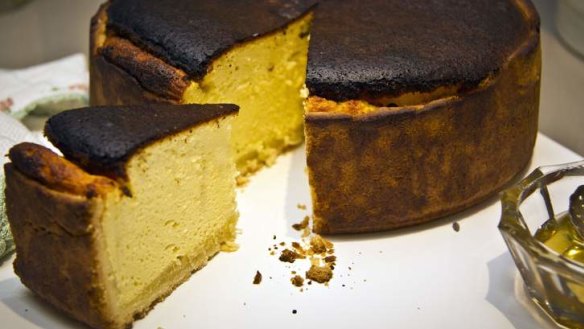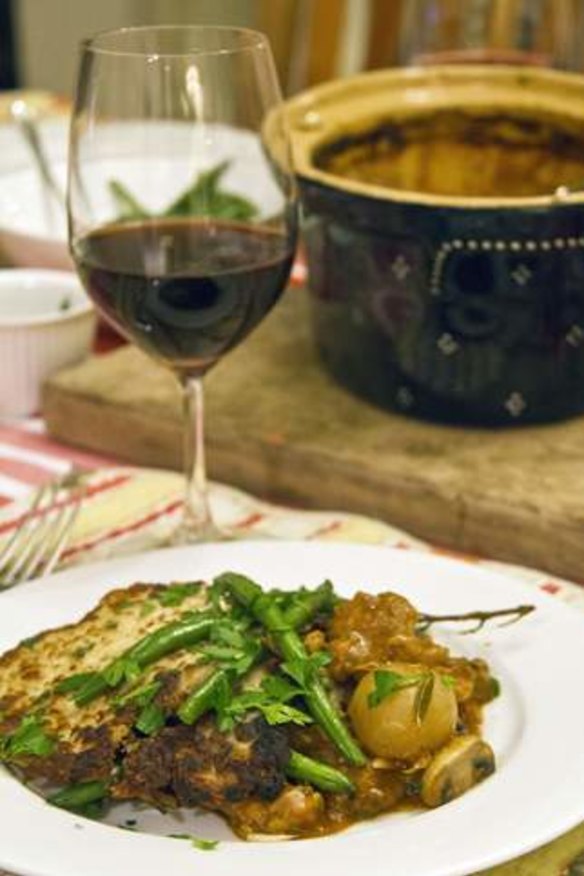The French concoction

Served in bistros all over France, veal marengo is a retro dish that comes with its own crazy legend with Napoleon Bonaparte at its centre. Marengo is a town in northern Italy where, in 1800, Napoleon was victorious over the Austrians.
The story goes that Napoleon's chef whipped up a celebratory dish using ingredients scrounged locally and named it chicken Marengo to honour the decisive battle. Fortunately, some of the original ingredients such as scrambled eggs and crayfish don't appear in current versions.
My memories of this dish aren't as auspicious. In the 1960s, when my mother wanted to impress at a dinner party, she would trot out chicken or veal marengo. It was served with a Napoleonic flourish, inside a ring of rice or buttered noodles, and we thought ourselves pretty sophisticated.

I haven't really been able to figure out when veal replaced chicken, why crayfish and eggs were ditched, or how and why mushrooms got involved. But the result is a hearty winter stew that is easy to make and delivers flavour considerably more than the sum of its parts. Made with veal, this dish is much richer and more complex than with chicken.
I first saw the odd-looking cake tourteau de chevre in a fromagerie in Paris. With its blackened exterior, it looked wildly out of place, like something had gone seriously amiss. In France, where fromageries don't sell anything but cheesy things, it was puzzling to see what appeared to be a burnt cake sitting among such royalty as comte, chevre, roquefort and boursin.
It wasn't until a wedge was offered to me as an aperitif with champagne some time later that it dawned on me that this was a true cheesecake.
The traditional French tourteau (recipe overleaf), made from goat's cheese and cooked at extreme temperatures, emerges as a high, blackened dome. The shape resembles a crab shell, and thus the name, tourteau, which can translate to crab.
The best type of goat's chevre is the one bought in a log, easily available from supermarkets or delis. Don't use an ash-covered goat's cheese or one that has a skin on the outside.
The sugar content in this cake can be varied for a sweeter or more savoury result for a cheese platter, as a starter or as a dessert with fruit.
This recipe is the dessert style. For savoury, omit the sugar and vanilla from the dough and the filling, but leave the Cognac or brandy in.
Debbie Skelton is a Canberra food writer, debsravingrecipes.blogspot.com
Veal marengo with potato rosti
Serves 4
3 tbsp plain flour, for coating veal
salt and pepper
1kg boneless veal, cubed
4 tbsp olive oil
2 tbsp unsalted butter
1 onion, chopped
1½⁄ tins diced tomatoes, drained
3 tbsp tomato paste
2 ½⁄ cups dry white wine
sprig of thyme, sprig of rosemary and 2 bay leaves
12 small eschalots, peeled
12 small white mushrooms, stems removed and wiped
10 baby potatoes, unpeeled
chopped parsley
Preheat the oven to 165C. Using a casserole dish that can also go on the stovetop, cut a round of baking paper big enough to fit the lid. This will reduce evaporation while cooking. I usually use my Chasseur pot.
Season the flour with salt and pepper and place in a large dish. Roll the diced veal in the flour to coat. Shake off excess flour and set aside.
To the ovenproof dish, add half the olive oil and place over high heat. Fry the veal in batches until brown, then transfer to a plate.
Wipe out the dish with a paper towel, add the butter and place over medium heat. Cook the onion for about five minutes or until soft. Stir in the tomatoes, tomato paste, wine and herbs. Add the veal and stir, bringing to a boil. Check for salt and pepper, adding more if needed.
Add a cup of water, the eschalots, the mushrooms and the potatoes and bring back to the boil. Remove the lid and place the baking paper circle on the top. Replace the lid and put into the preheated oven to bake undisturbed for 45 minutes until the potatoes and onions are softened. Fish out the herbs and discard. Serve with a sprinkle of parsley and potato rosti.
If you feel inclined to replicate retro, you could serve this dish with buttered thick noodles or boiled rice.
Potato rosti
Makes 4 large rosti
3 medium potatoes
3 tbsp flour
1 tbsp butter
1 tbsp duck fat or oil
salt and pepper
pinch of nutmeg
Parboil the potatoes whole with skins on in salted water until just tender, but not soft. Cool and chill for a couple of hours.
Coarsely grate the potatoes and squeeze out excess liquid. Mix in the flour, salt, pepper and nutmeg.
Heat half the butter and fat in a small, heavy-based frypan on a high heat. Add a heaped tablespoon of the potato mixture to the pan and press down with the back of a spoon to form a flat pancake. Allow to cook for a few minutes, shaking the pan to loosen the potato cake.
When the cooked side is crispy and golden, using a spatula or egg lifter, carefully turn the rosti over to cook the other side. Place on a paper towel while you cook the other rosti.
Tourteau de chevre - goat's cheese cake
Base
1¼⁄ cups plain flour
1 tsp sugar
pinch salt
375g butter, cold and diced
1 large egg
4 tbsp iced water
Filling
5 large eggs, at room temperature, separated
pinch salt
½⁄ cup sugar
240g soft goat's cheese
3 tbsp cornflour
½⁄ tsp vanilla paste
3 tsp Cognac or brandy
For the pastry, place the flour, sugar and salt into a food processor and pulse to blend. Scatter over the butter and pulse until coarsely mixed in. You can also mix this by hand.
Beat the egg and the iced water together in a small jug and add in two batches to the dough, pulsing after each addition. The dough should just hold together when pinched. If it doesn't, add a little more iced water. Don't overwork this dough or it will become tough.
Turn out on to a floured surface and gather into a ball. Flatten into a disk, cover with cling wrap and chill for a few hours. It will last up to five days in the fridge.
Preheat the oven to 210C or the highest setting on your oven. Grease a 20-centimetre springform pan. Line a baking tray with baking paper.
On a lightly floured surface, roll the dough into a circle about 30 centimetres wide. Press the dough into the pan and up the sides as evenly as you can, then trim if necessary. (When the cake is cooked, the crust disappears into the filling so an uneven edge is not too obvious.)
Whip the egg whites with the salt in an electric mixer until they form soft peaks. Still whipping, gradually add two tablespoons of sugar and beat until the mixture holds glossy peaks. Set aside.
Separately, using the paddle beater on an electric mixer, beat the egg yolks, crumbled goat's cheese, the remaining sugar, the cornflour, vanilla paste and Cognac, for about a minute or until very smooth and creamy.
Using a spatula or metal spoon, stir about a quarter of the egg whites into the egg yolk mixture to loosen it, then gently fold in the remaining egg whites. Scrape the batter into the crust and place the pan on the baking-paper-lined tray to catch any leaks.
Bake for 15 minutes, then reduce the oven temperature to 180C and bake for another 30-35 minutes or until the top is cracked and dark brown. The cake should be firm and a skewer inserted should come out clean.
Cool in the pan for about 15 minutes, then carefully remove. Serve at room temperature. The cake will drop as it cools.
For dessert, serve with pear or figs drizzled with a light honey and creme fraiche or yoghurt. With a cheese platter, serve with light honey to drizzle.
The best recipes from Australia's leading chefs straight to your inbox.
Sign up